There are numerous styles of decorating your window - from classical to fashionable vanguard, from wonted European to exotically Oriental. However the style most often used nowadays is Eclectics – the mixture of different styles as maintaining pure style in furnishings is very complicated. Our designers will help you to find the style, colour scheme and type of material best matching to the concept of your interior. You can either order an individual design project or choose a fitting make from a magazine or a catalogue. You can view the works of our designers in our Gallery.
To have the soft furnishing of the room matching to your window design, you can order the curtains along with it – coverlets, tablecloths, cushions, baldachins, etc.). You can get more detailed information about our sewing services here.
Classical curtains
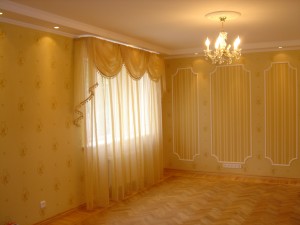 Classical style is expensive; furnishings of this style are usually ordered by wealthy people for themselves and the next generations.
Classical style is expensive; furnishings of this style are usually ordered by wealthy people for themselves and the next generations.
Classics is never out of date, therefore this style is still the most popular.
Emphasizing the shape of the window, the classical curtains form entirety, regardless the variety of materials that can be used in their production. Classical curtains bring calm, warm and cosy atmosphere to your room, gives it posh and accomplished look. Almost any material can be used for these curtains – silk, embroidered tulle, gobelin, jacquard, tulle, damask, chenille, etc.)
Additional accessories for curtains like cords, traces, tiebacks, decoration boarders, ruffles are used for classical curtains. They give the curtains refinement and allow controlling the amount of light flooding into the room.
Exclusive curtains
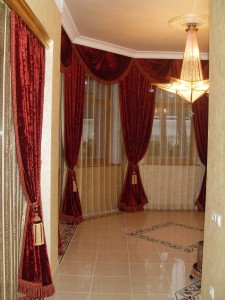 Exclusive curtains are manufactured in accordance with an individual design project, according the interior of the client’s premises. The style of exclusive curtains has no set boarders. They can be accomplished in one style (i.e. classic, country, ‘hi-tech’), be a combination of several styles, or be unattached to any exact style. Only your requirements and of course the budget envisaged for this project can set limits to the fantasy of our designer. Also the price of such curtains has no fixed limits; the sum can be relatively small if you choose cheaper materials and curtain tracks, as well as it is possible to create prestigious curtains embodying the taste and financial potential of their owner.
Exclusive curtains are manufactured in accordance with an individual design project, according the interior of the client’s premises. The style of exclusive curtains has no set boarders. They can be accomplished in one style (i.e. classic, country, ‘hi-tech’), be a combination of several styles, or be unattached to any exact style. Only your requirements and of course the budget envisaged for this project can set limits to the fantasy of our designer. Also the price of such curtains has no fixed limits; the sum can be relatively small if you choose cheaper materials and curtain tracks, as well as it is possible to create prestigious curtains embodying the taste and financial potential of their owner.
The curtains manufactured according exclusive project are unique, made only for you and in accordance to your wishes and requirements; that forms their main value.
Roman blinds
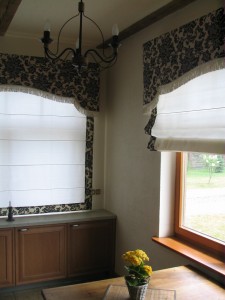
The Roman blinds are set up as follows: the material is attached to the head rail by hook and loop fastener. Due to the specific rail mechanism and the curtain weighting tape at the hemline, the curtain can be drawn up in soft plaints. The easy to use self-locking pulley mechanism allows fixing them at any convenient height. The sunlight is hushed down by various density of the material.
Usually the Roman blinds are made from heavy portiere materials, however other options are available as well.
The constructional peculiarities of Roman blinds do not allow maintaining the entirety of the design of material at the point of plaits, but exactly that gives them additional charm by creating the effect of a wave.
Japanese blinds
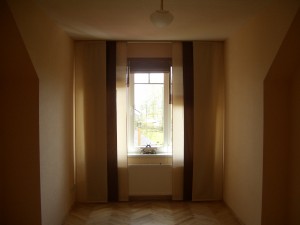 Japanese blinds (also familiar as Japanese panels or screen blinds) are formed by two or more absolutely flat strips of fabric. Which do not get bent but are slid like screens or panels.
Japanese blinds (also familiar as Japanese panels or screen blinds) are formed by two or more absolutely flat strips of fabric. Which do not get bent but are slid like screens or panels.
Metal poles are set at top and bottom of the curtain to prevent it from bending. This type of curtains is perfect for people who appreciate original materials with unusual texture or finishing. Additional saving grace of Japanese blinds – they hardly collect dust.
These simple and practical blinds will go perfectly with an interior executed in minimalist style. They best fit to spacious rooms with big windows. Japanese blinds do not look that effective on small windows, as they require space. Japans blinds can also be used to divide room to several zones. They are different from other ways of window decoration with their minimalism, strict forms and laconism – typical features of Japanese style in interior.
Japanese blinds can be made of different materials. You can choose any fabric and order these blinds after individual project or a catalogue. Special dust and dirt proof materials are also available.
French blinds
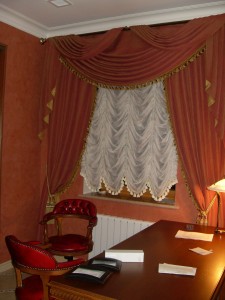 French blinds are from a strip of fabrics split in several vertical sections that are formed by measured, semicircular plaits. Tightening the cord through a row of vertical eyelets forms the ruffles at the bottom of the blind when the blind is raised. Usually natural silk in light tones of light, transparent material of any colour is used for French blinds.
French blinds are from a strip of fabrics split in several vertical sections that are formed by measured, semicircular plaits. Tightening the cord through a row of vertical eyelets forms the ruffles at the bottom of the blind when the blind is raised. Usually natural silk in light tones of light, transparent material of any colour is used for French blinds.
French blinds are perfect for living room or bedroom, which are furnished with classical or antique furniture.
In every home the bedroom is a special place with intimate atmosphere, therefore using French blinds with cascades of soft pleats and frills in decorating its window will grant sophistication to your interior.
French blinds get often combined with classical heavy curtains with fringes and lambrequins.
Austrian blinds
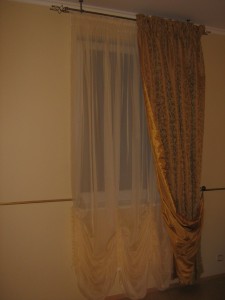
The top of the blind is pleated with the help of a special tape or by hand. The same idea can also be used also for lambrequins. Austrian blinds and lambrequins look especially effective if made of glossy materials – silk, taffeta, polyester.
Austrian Blinds are generally made up in lightweight curtain fabrics, they will hang better and exclude more light if they are lined. They can be hung inside or outside the window recess. If they are hung outside the recess they can be frilled at the side and bottom edges. However, if they are hung inside the recess, they look better if a frill is added to the bottom edge only.
It’s the best to finish the austrian blind off with some complicated decoration. Austrian blinds combine well with classical heavy curtains and lambrequins.
Rollup blinds
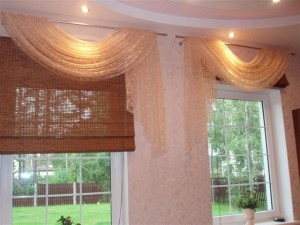 Rollup blinds – is one of the most practical ways of decorating your window. Roll blinds are formed by a strip of material that is rolled up on a pole at the ends of which there are special thimbles providing the tension of the blind. The control is performed with the help of special mechanism – spring roller, bedded chain or cassette type.
Rollup blinds – is one of the most practical ways of decorating your window. Roll blinds are formed by a strip of material that is rolled up on a pole at the ends of which there are special thimbles providing the tension of the blind. The control is performed with the help of special mechanism – spring roller, bedded chain or cassette type.
Fixed at requited height rollup blinds softly diffuse sunlight. Along with the light or heavy curtains rollup blinds can create warm atmosphere in living room or children’s room and pleasing dusk in bedroom.
Rollup blinds can be used in places like kitchens or glassed-in loggias, where use of heavy curtains is impossible. Thanks to variety of fabrics it is possible to control the level of flow of light within the room. If the windows face the sunny we recommend the use of sun reflecting materials.